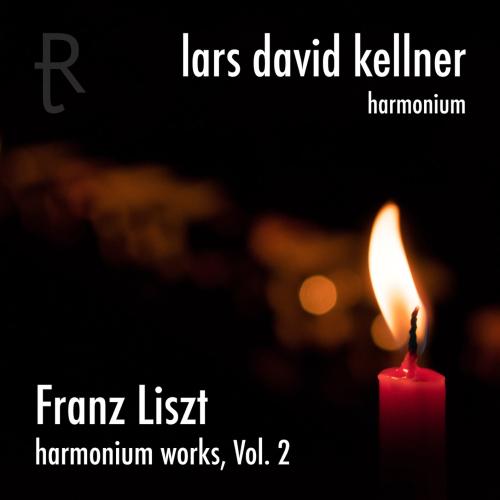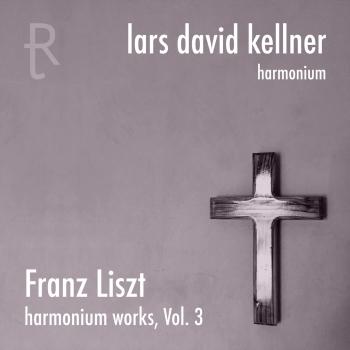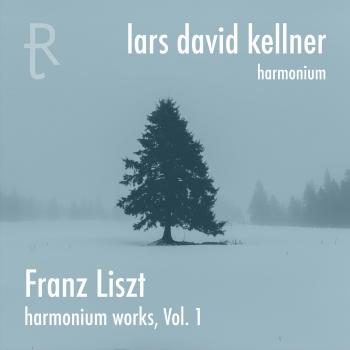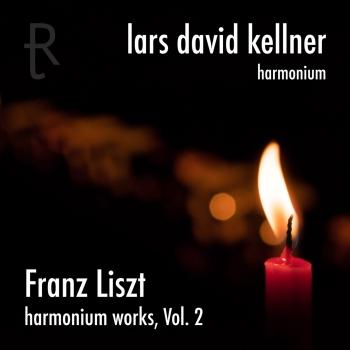
Franz Liszt: Harmonium Works Vol. 2 Lars David Kellner
Album info
Album-Release:
2021
HRA-Release:
14.12.2021
Label: recordjet
Genre: Classical
Subgenre: Chamber Music
Artist: Lars David Kellner
Composer: Franz Liszt (1811-1886)
Album including Album cover Booklet (PDF)
- Franz Liszt (1811 - 1886):
- 1 Années de pèlerinage: Angelus!, S. 672c 08:06
- Zwei Kirchenhymnen, S. 669:
- 2 Zwei Kirchenhymnen, S. 669: Salve Regina 07:08
- 3 Zwei Kirchenhymnen, S. 669: Ave maris stella 05:32
- Rosario, S. 670:
- 4 Rosario, S. 670: Mysteria gaudiosa 01:15
- 5 Rosario, S. 670: Mysteria dolorosa 01:21
- 6 Rosario, S. 670: Mysteria gloriosa 01:39
- Franz Liszt:
- 7 Ora pro nobis, S. 262 06:45
- Choräle, S. 504b:
- 8 Choräle, S. 504b: Vexilla Regis 02:18
- 9 Choräle, S. 504b: Crux ave benedicta 02:25
- 10 Choräle, S. 504b: Jesu Christe 02:48
- 11 Choräle, S. 504b: Wer nur den lieben Gott läßt walten 01:38
- 12 Choräle, S. 504b: Was Gott thut, das ist wohlgethan 01:38
- 13 Choräle, S. 504b: Meine Seel erhebt den Herrn 01:23
- 14 Choräle, S. 504b: Nun ruhen alle Wälder 02:00
- 15 Choräle, S. 504b: O Haupt voll Blut und Wunden 01:54
- 16 Choräle, S. 504b: O Traurigkeit 02:12
- Franz Liszt:
- 17 O Roma nobilis, S. 669c 01:56
Info for Franz Liszt: Harmonium Works Vol. 2
That the harmonium was not just an instrumental fringe phenomenon or an exotic stylistic device for Franz Liszt is proven by his numerous works expressly (exclusively or alternatively) scored with harmonium. As is well known, he owned several such instruments himself and certainly contributed to their tonal and technical development, as is also and especially true for the piano and the orchestra.
If one has the (rare) opportunity to hear Liszt's works performed on a suitable harmonium, it quickly becomes clear why the composer intended them for exactly this instrument. There is not only the internalized sound as an expression of religious contemplation and devotion, especially in the case of suction wind instruments, not only a strong ability of the registers to blend together with simultaneous dynamic flexibility, the ability of the player to breathe on the instrument in a deliberate and audible manner, but also - assuming skilful registration - an almost orchestral range of voices and the plenum, without the often intimidatingly overwhelming sound mass of an organ. With skilful use of the instrumental means of the harmonium, details thus shine forth that are likely to provide new insights even for those familiar with the compositions.
The second album presented here by pianist and harmonium specialist Lars David Kellner aims to bring Liszt's unjustly sidelined harmonium works back to light and remind us of their special place in the composer's oeuvre. This album includes several solo works by Franz Liszt, recorded for the first time with a suction wind harmonium.
Lars David Kellner, harmonium
Lars David Kellner
Lars David Kellner's CD recordings include a number of bravura pieces for piano literature: Modest Mussorgsky's Pictures at an Exhibition is one of them (published 2010), as well as sonatas and ballads by Sergei Rachmaninoff or Frédérik Chopin (2008). However, Kellner sees himself not only as a virtuoso pianist, but rather as a (keyboard) artist in a broader sense: in addition to the piano, the harmonium has been of special importance to him for some years now. With many premiere recordings he is making an active contribution to the revitalization of this special keyboard instrument. The artist's latest album with solo works by Franz Liszt, which was released in 2020 on renowned audiophile portals, is recorded on a harmonium from Kellner's instrument collection. Kellner puts great importance to bringing his audience closer to lesser known compositions for unusual keyboard instruments in their very own sound language.
It is of utmost importance for the artist to penetrate musical works comprehensively. After meticulous study of the sources, Kellner recorded the complete piano works by Leoš Janáček in their earliest version. The publication of these sound recordings, new to the world of music, caused an international sensation: ‘He posseses a full-bodied and rounded sound and solid technique, making the hardest passages sound easy. (...) His freedom with the music (...) is exceptional’ (Fanfare Mag, 8/2014). Kellner's Mussorgski album with recordings on the Horowitz grand piano was also highly acclaimed in the American Record Guide: ‘Kellner (...) finds the inner voices and deals effectively with contrasts. He reminds me of Ashkenazy’ (ARG, 12/2011). The complete Pictures at an Exhibition were premiered by Kellner in their first version (2011). His piano recitals (e.g. at the Gasteig München) and concerts with harmonium and celesta were well received by the audience and caused wide media coverage.
Since the foundation of tastenReich® (2017) Lars David Kellner's chamber music collaboration with artists such as Jürgen Geiger, Anastasia Sobyanina and other keyboard virtuosos has intensified. His love for romantic songs led to intensive concert activity with singers like Susanna Proskura or Marina Ushchapovskaya. Lars David Kellner adapted the Russian lyrics of Rachmaninoff's fourteen "Lieder ohne Opuszahl" into German, in order to bring them closer to the local audience. They were published by Sikorski Musikverlage Hamburg in 2015.
Lars David Kellner, born in 1973 in Weiden/Germany, is a pianist with multiple diplomas from the Munich Academy of Music (2001) and lives in Bavaria. His musical education was accompanied by Franz Ondrušek, Erich Appel and Karl-Hermann Mrongovius. He received artistic inspiration from Eckart Besch, Klaus Schilde and Elza Kolodin at international master classes. Kellner is a member of the German Liszt Society, the Karg-Elert Society and is on the board of the Friends of the Weiden Max-Reger-Tage.
Booklet for Franz Liszt: Harmonium Works Vol. 2












